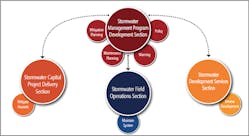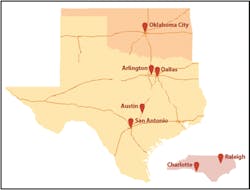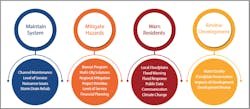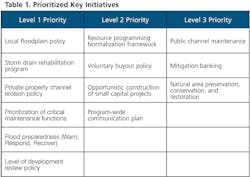The City of Fort Worth, TX, established a Stormwater Utility in 2006 to provide a consistent revenue stream to support a stormwater management program. Prior to that time, City efforts relative to stormwater management were almost exclusively reactionary, and the City had little information to adequately understand the nature and magnitude of stormwater issues throughout the City, much less take steps to mitigate them. Consequently, the first 10 years of the program were focused on obtaining fundamental asset management information while also trying to mitigate some of the most chronic and obvious stormwater management problems facing the City.
By 2016, the program had acquired a great deal of key management data, had learned much about the disposition and priorities of the community and elected officials toward stormwater management, had a much greater understanding about the feasibility of mitigating the range of stormwater needs within program resources, and had clearly identified several needs for fully vetted, city council-endorsed policies to facilitate a consistent and strategic approach to several recurring, sensitive issues. Stormwater management staff realized that, to optimize the use of program resources to best meet the needs and goals of the community, significant effort was needed to assimilate and understand the information and lessons learned during the first 10 years of the program to develop a strategic direction that was realistic, well-prioritized, and responsive to the needs of the broader community.
In the fall of 2016, the City kicked off a year-long effort to update the stormwater program’s master plan to learn lessons from the past and ensure limited resources were being optimally used to best meet the current and future needs of the community. The strategic master plan update process was developed and executed to
- assimilate and interpret the key data already acquired to help define the current state of the program,
- supplement existing data with the perspectives of key internal and community stakeholders/partners and benchmark communities,
- outline key policy needs and considerations for recurring challenges to bring about future formalized policies that will provide clear direction and standardized decision-making,
- distill all of the input to inform a strategic program direction,
- develop an actionable, tactical approach from the strategic plan outcomes to effectively manage the program, monitor progress toward strategic goals, and make course corrections in response to changing circumstances and priorities, and
- gain stakeholder and city council endorsement of the strategic plan.
This article summarizes the background of the City of Fort Worth’s stormwater management program, the engagement and planning process undertaken to update the program’s strategic master plan, and the key steps for successfully moving from a strategic plan to an annual, tactical plan that effectively advances the identified strategic direction and initiatives.
Background
The mission of the City of Fort Worth’s stormwater program is to protect people and property from harmful stormwater runoff. The program achieves this mission through four program elements:
- Maintaining the stormwater system such as pipes and channels
- Mitigating hazards through capital projects
- Warning the community of stormwater hazards
- Reviewing development for compliance with city standards
The program’s mission and program elements, in addition to the City’s overarching mission, vision, and strategic goals, guided the direction for the master plan update.
To address the four program elements, the stormwater management program is divided into the following sections: program development, capital project delivery, field operations, and development services. As shown in Figure 1, the program development section is responsible for establishing the program’s strategic direction.
Process
The master plan update was the result of an in-depth, holistic, and inclusive process to assess existing efforts to date; engage stakeholders and the public; hear and learn from stormwater staff, partner departments, and related City strategic plans and reports; and identify best practices from comparable stormwater programs in other communities. The information derived from this process was used to outline program challenges and develop a strategic asset management framework to optimize budget and staff resources that were informed by community needs, industry best practices, and the indications of well-developed prioritization tools.
Intradepartmental and Interdepartmental Engagement. Stormwater program staff were engaged throughout the planning process to identify needs and priorities from those with the most knowledge of the day-to-day programs and tasks. A visioning session was initially held with program leaders to outline the vision for the Fort Worth community related to stormwater and the vision for the stormwater program, identify major unknowns and drivers of change, and determine how each of the four program elements contributes to achieving the vision. Leadership outlined lessons learned, the program’s accomplishments and current situation, and short- and long-term goals, and performed a gaps and needs assessment. Program staff were engaged next to share the vision and gain feedback and buy-in on the direction forward. The internal engagement also included interdepartmental coordination to identify opportunities to collaborate across City divisions and departments that have overlapping interests and goals.
Numerous documents and plans from other City departments and programs were reviewed to identify initiatives that could influence the strategic direction of the stormwater master plan. This review helped ensure that the master plan is consistent with the current City direction and avoids conflicts with the planning objectives of other City programs. This review also helped identify potential opportunities where the program may be able to partner with other City efforts to implement future policies and strategies.
Stakeholder and Public Engagement. A stakeholder group was created to help guide the planning process and provide feedback on major policy considerations. The group was composed of representatives from each city council district and ad hoc representatives from various stormwater ratepayer categories. Four open-to-the-public stakeholder meetings were held during a 10-month period. TurningPoint electronic polling software was used during meetings to collect stakeholder feedback and instantly show the results. Discussion of the results with the stakeholders then followed to better understand the polling findings. In addition to formal meetings, a relationship was built with the stakeholders through more frequent informal group and one-on-one meetings, phone calls, and emails throughout the planning process. The stakeholder group showed great commitment to the process and their valuable feedback helped guide the strategic direction and policy development needs identified in the master plan update. Stakeholder group discussions provided input on program challenges, the relative priority of each of the four program elements, and the resulting strategic direction and key initiatives outlined in the master plan update. Additionally, the group was engaged in discussions on each of the four major policy challenges facing the stormwater program. Ultimately, the stakeholder group endorsed the planning process and the program and policy directions identified in the master plan update.
The public was invited to attend the series of stakeholder meetings, and feedback was requested through written comments and open comment periods during the meetings. A dedicated website and social media were also used to inform the public and solicit feedback during the planning process. A 2017 community survey was also reviewed to better understand the public’s perception of stormwater needs compared to other city services.
Peer Community Review. The identification of current best practices and potential improvement opportunities for the program were sought through comparisons with peer communities. Seven peer communities (Figure 2) were contacted and interviewed as part of the planning process. Communities were selected based on one or more of the following criteria: similar stormwater infrastructure responsibilities, similar funding model, similar community size, regional proximity, and nationally recognized stormwater programs. Program staff and stakeholders brought forward ideas for what to ask the communities in an effort to validate the internal program staff assessment, learn from others, and inform the master planning process.
An extensive survey was developed and filled out by each community that provided ideas and helped inform the evaluation of current and future policies and strategies. A follow-up phone call was held with most communities to better understand survey responses. The topics shown in Figure 3 were included as part of the peer community review survey.
Challenge Identification. The results of the internal engagement, peer community review, and stakeholder and public engagement helped identify and gain input on the significant challenges facing the Fort Worth stormwater program. These challenges can affect every program element as the City strives to meet the program’s mission. Understanding and effectively dealing with each challenge was key to the development of the program’s strategic direction for the next 10 years. Overall program challenges were identified as well as specific program element challenges and policy challenges.
Prioritization Tools and Strategic Framework. The City of Fort Worth stormwater program funding structure is expected to be consistent and reliable for the foreseeable future but is inadequate to address many high-priority needs. The strategic direction established through the master plan update process was formulated to most efficiently and effectively accomplish the mission of the program based on the available resources with the identified challenges and community needs and priorities in mind.
Several tools developed since the formation of the program were used to help inform the strategic direction identified in the master plan update. Tools consisted of citywide mapping of flood-prone areas and areas of erosion hazard potential, reported flood incidents and repetitive loss areas, prioritization of drainage areas, capital projects, maintenance projects, criticality of stormwater infrastructure, stream crossing inventory, and citywide pipe capacity estimates.
In the future, these tools will be leveraged to inform resource utilization to ensure the program is focusing on the most critical needs and is responsive to community priorities. Tools will be used in the development of a framework to assist with the prioritization and normalization for various categories of need being assessed and ranked so the urgency of the different needs and relative benefits of addressing the needs can be compared. Heavy emphasis will continue to be made on refining and appropriately applying these tools in the future. Use of the tools will provide an objective and defendable way to identify and prioritize program services and resource allocation among the program’s four program elements (maintaining infrastructure, mitigating hazards, warning of hazards, and reviewing development) and within each individual program element.
In addition to program strategic directions, policy strategic directions were also established during the master plan update. Key policy issues that were discussed and advanced as a part of the planning process included local (non-FEMA) floodplains, severe private property channel erosion, buyouts for flood and erosion mitigation, and level of review of private development.
The stakeholder and public feedback received confirmed that some sort of policy in each of these areas should be developed and/or refined. Policy developments or refinements will need to be thoroughly vetted to ultimately determine the preferred direction for the City. Policy development and refinement for each policy need will provide the City and stakeholders with clear direction to streamline and standardize future decision-making in these areas.
Implementation
Moving from a strategic plan to an annual, tactical plan is key to progressively advancing the strategic direction and prioritized initiatives outlined in the master plan update.
Successful implementation of the strategic direction identified in the master plan will entail the following:
- Translating high-level vision and broad priorities into actionable and measurable steps
- Developing and executing a plan to take those steps
- Monitoring and reporting progress
- Adjusting the course over time as needed to ensure the program direction remains consistent with the overall strategy while being responsive to evolving community needs and other dynamic factors that can impact program direction and priorities
The activities listed above are vital for keeping the strategic direction fresh and ensuring that the tactical work plan remains driven by the strategy. Three key aspects were identified to ensure the sustainable and effective implementation of the strategic direction: ongoing stakeholder engagement, the development and use of an annual business plan, and change management.
Ongoing Stakeholder Engagement. Development of the updated master plan involved a robust dialogue with internal and external program stakeholders. Ensuring that the program remains true to the strategy developed and adequately informed by and responsive to stakeholder perspectives will necessitate structured and intentional means for ongoing intradepartmental and interdepartmental coordination and stakeholder engagement.
The Stormwater Program Development Section will lead the ongoing stakeholder engagement process and will be responsible for implementation of and adjustments to the program strategic direction. All program sections will be fully involved in the process to ensure that both the strategic direction and annual work plans are appropriately informed by the experience and perspective of frontline service delivery staff.
Interdepartmental coordination will continue to be leveraged to create opportunities for shared objectives and mutual benefits. In addition, program staff will continue to coordinate with City leadership through the plan commission, informal reports, and city council briefings.
The future program stakeholder group is intended to include representatives from various customer groups that are subject to the stormwater utility fee, understand the program, and can provide feedback on key initiatives as well as the future strategic direction of the program. The group will be responsible for speaking objectively on key topics and representing their own perspectives as individuals while seeking the greater good of the City.
The stakeholder group will help the program stay in touch with changing community needs and values. Feedback from this group will help guide the overall strategic direction and program resource allocations. Stakeholder group members will be asked to commit to regular attendance and active participation in order to provide group consistency. The group is not expected to always reach a consensus on specific topics or initiatives during these relatively informal meetings. The feedback, though, will always be valuable and influential in providing both pros and cons from the customer perspective for consideration by the City staff, who will be responsible for final decisions.
Several working subgroups will be formed to be responsible for more detailed vetting of the implementation of specific key initiatives. All the identified policy initiatives will be developed and vetted through small working groups. Working groups are intended to include participants with special interests, practical experience, and technical expertise regarding the key initiative. Feedback and recommendations of the working subgroups will be provided to the larger stakeholder group and the public for vetting purposes.
Working group meetings will be held at key junctures in the process of developing a specific policy or strategic initiative. Working groups will meet more frequently than the stakeholder group and discontinue meetings as the initiative is completed or the strategic direction is established. The program will seek commitments from group members to regularly attend and actively participate in meetings to better provide both pros and cons from the customer perspective for consideration by the larger stakeholder group and the City staff who will be responsible for final decisions.
Annual Business Plan. The program will develop an annual business plan that will be the primary working document to show how ongoing services, activities, and initiatives support the strategic direction, relate to program resources, and are measured to ensure the desired progress toward goal accomplishment is being made.
The strategic direction in the master plan will drive the program’s annual business plan and will:
- document the connection between annual program resource allocations overarching City goals, the long-term strategies, and key initiatives identified in the master plan update;
- depict the role of each program section within the greater context of the program;
- establish key performance indicators and performance measures to assess the progress and monitor the service levels of the program;
- create a detailed roadmap for how program goals and commitments are met;
- connect program key initiatives with tactical staff level objectives;
- document resource allocation decisions that drive the program annual budget submission;
- facilitate a process and establish a framework for strategic input of key program staff; and
- identify ongoing or developing factors that could have a significant impact on program strategies and priorities.
The strategic direction identified in the master plan led to the identification of 13 key strategic initiatives. The implementation priorities indicated in Table 1 were established for these initiatives in coordination with City staff, stakeholders, and the public.
The priorities of the initiatives are considered relative to each other based on the magnitude of their potential impact on the community. Level 1 initiatives are the highest priority and level 3 the lowest. The actual schedule for initiating and completing work on each initiative will be driven by staff resources. The future program business plan will refine the implementation objectives, schedule, and performance measures in more detail for each initiative.
Change Management. It is a given that new challenges will evolve that impact the strategic direction and key initiatives identified in the master plan. Seeking to anticipate potential changes will allow the program to respond effectively when these occur.
Each of the following items has the potential to significantly impact the direction, structure, priorities, and service expectations/demands of the stormwater program:
- Federal and state regulations
- Major flooding events
- Rehabilitation costs or needs that exceed expectations
- Critical infrastructure failures
- Partnership opportunities
- Community initiatives
As a part of the ongoing maintenance and implementation of the program master plan and annual business plan, program staff will work to stay abreast of emergent issues in the above categories, and others, to posture the program to respond as efficiently and effectively as possible to changing requirements and expectations.
Conclusion
It is a complex initiative requiring sound judgment to assess the current state of a multi-faceted program, adequately understand community needs/priorities relative to the program, and pivot off that to develop a strategic program management plan. Achieving a high-value outcome from such an initiative necessitates a very thorough, well-designed, and well-executed process.
It is essential, though, to periodically go through this sort of process to learn lessons from the past and ensure that limited resources are being optimally used to best meet the current and future needs of the community. More information on the City of Fort Worth’s strategic stormwater management program master plan can be found at www.fortworthtexas.gov/StormwaterMasterPlanUpdate/.










